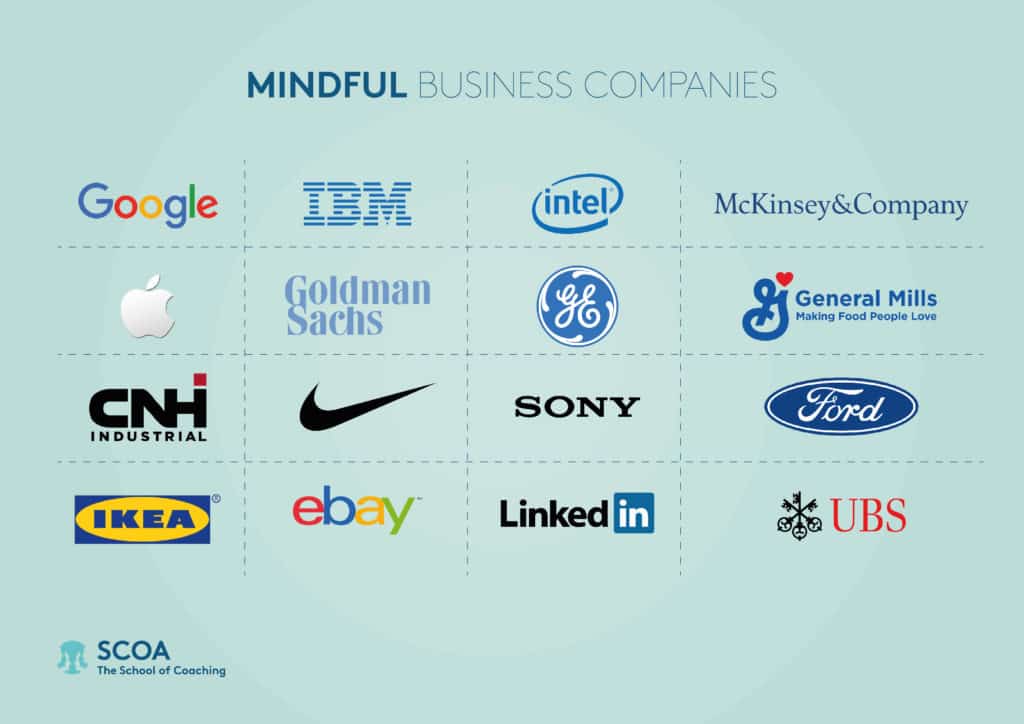(Read here for the Italian version)
The Mindful revolution Over the past few yeas mindfulness has captured the public psyche. In February 2014, Time magazine dedicated its cover to, “The Mindful Revolution”, with the subtitle, “The science of finding focus in a stressed-out, multi-tasking world”. The Harvard Business Review in 2015 noted that mindfulness is close to taking on cult status in the business world. It has been embraced by companies such as Google, Apple, IBM, CNH I, Intel, McKinsey & Company, General Electric, General Mills, Goldman Sachs, Nike, Sony, Ford, Target, IKEA, eBay, LinkedIn, UBS Italia, the Italian Stock Exchange. This may seem like a long list, but is far from comprehensive. Even the US Marines use mindfulness training. A study found that those Marines who trained in mindfulness experienced improved mood and working memory. Under pressure, they were more capable of complex thought and problem solving and they had better control of their emotions.
Why has mindfulness become so popular
Considering that mindfulness is not a new concept but has been around for 2,600 years why has it become so popular recently? I believe the answer lies in the fact that the world we live-in is becoming more and more frenetic as described by the acronym VUCA – volatile, uncertain, complex and ambiguous. Technology, the internet of things, industry 4.0, the pace and rate of change is altering how we live our lives and how we do business. We are connected 24/7 and there are constant calls on our attention. We don’t get a chance to switch-off. I believe that mindfulness has become popular because have never needed mindfulness more than we do at the moment.

The science Another reason for the rise of mindfulness is that its efficacy is supported by evidence-based research, the gold standard in science. A vast body of study using the latest medical imaging technology and techniques in neuroscience have shown not only that mindfulness works but why. Neuroscientists at Harvard have shown that after just eight weeks of training in Mindfulness Based Stress Reduction (MBSR) there is a significant increase in brain grey matter concentration in areas associated with sustained attention, emotional regulation and perspective taking. The training also increases activity in your left prefrontal cortex – a predictor of happiness and well-being. And it boosts your immune response. Mindfulness training gives you more insight into your emotions and it increases your level of attention and concentration. It’s been shown to help with stress, anxiety, depression and addictive behaviours and it has a positive effect on issues like hypertension, heart disease and chronic pain. It has also been shown to raise one’s level of emotional intelligence and improve relationships.
Mindfulness and Business
OK so the thousands of scientific studies and over 150 Harvard Business Review articles show us that mindfulness works. But why are companies investing in mindfulness? What about the fundamental question in business, ” WHAT IS THE RETURN ON MY INVESTMENT? How can we make quantify a qualitative result?
Here are two companies that have quantified the effect, SAP and AETNA.
SAP, is a German company and one of the largest enterprise software manufacturers in the world with over 96,000 employees serving over 450,000 customers globally and earning revenues of E23bn. The company declines to detail how much it is spending on mindfulness but says it has seen a whopping 200 percent return on investment, with a rise in employee engagement and a fall in absenteeism. They measured a series of metrics such as engagement, focus and productivity pre and post mindfulness – over a six-month period.
What they found is that compared to control groups, participants in the mindfulness courses were statistically significantly higher on the above measures, compared to people who hadn’t done the training.. According to SAP’s calculations, a 1 percentage point increase in employee engagement corresponds anywhere from 50 to 60 million euros in operating profit. At the same time, a 1 percentage point increase in its business health culture index can boost profits by 85 to 95 million euros. Things like wellness, focus, a decrease in stress, an increase in creativity and collaboration, correlated directly to business outcomes that they could put a dollar value to and thus the 200% return on investment.

Putting this into context, U.S. companies saw an average return on investment of $3.80 for every $1 they invested in disease management programs, but only 50c for every $1 spend on lifestyle initiatives, according to a 2013 study by public policy research body Rand Corporation.
From the point of view of the partecipant’s experience, after attending the mindfulness course Daniel Holz, SAP’s managing director for Germany, said “The course helped me learn how to shut out the noise of everyday life and concentrate on what really matters, …I have more mental peace and feel more balanced”. According to Peter Bostelmann, an industrial engineer who heads the mindfulness initiative in SAP, “This is no hippy-dippy stuff…It is proven by scientific evidence, but also proven by what you can feel yourself.”
Aetna is a US health insurance company with almost 50,000 employees and 39 million customers. Following a serious skiing accident, the now CEO came across mindfulness Having experienced the benefits personally, in 2011, he decided to begin offering mindfulness-based programs to associates in Aetna. The company measured the effects in a large study and found that the program produced more than a 35 percent decrease in perceived stress. Participants also reported a 20 percent improvement in sleep. On average they saved about 62 minutes per week in terms of focus and productivity and it amounted to about $3,000 per employee in cost savings because they were more productive.
In summary, practicing mindfulness provides a series of benefits on wellbeing, concentration, stress reduction, improved immune response and social interaction. Interestingly, it also has a positive impact on the bottom line. It is, also, very cost effective. You don’t need special equipment. All you need is a qualified and competent teacher (this has been proven to be a differentiating factor), a chair or mat or cushion and you are good to go. Sounds too good to be true but it really does work.
Mindfulness: a summary of reported benefits
Emotional Wellbeing, Memory and Creativity
Professional Performance
Improved Decision Making
Greater focus and attention
Lower Employee Turnover
Reduced Absenteeism
Higher Emotional Intelligence
Increased Physical Wellbeing
Improved Brain Functioning
Better Immune system





